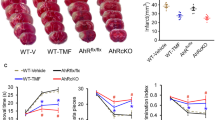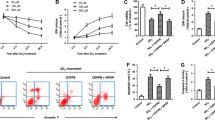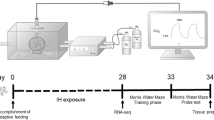Abstract
The neuroprotective potential of 3,3′-diindolylmethane (DIM), which is a selective aryl hydrocarbon receptor modulator, has recently been shown in cellular and animal models of Parkinson’s disease and lipopolysaccharide-induced inflammation. However, there are no data concerning the protective capacity and mechanisms of DIM action in neuronal cells exposed to hypoxia. The aim of the present study was to investigate the neuroprotective potential of DIM against the hypoxia-induced damage in mouse hippocampal cells in primary cultures, with a particular focus on DIM interactions with the aryl hydrocarbon receptor (AhR), its nuclear translocator ARNT, and estrogen receptor β (ERβ). In the present study, 18 h of hypoxia induced apoptotic processes, in terms of the mitochondrial membrane potential, activation of caspase-3, and fragmentation of cell nuclei. These effects were accompanied by substantial lactate dehydrogenase release and neuronal cell death. The results of the present study demonstrated strong neuroprotective and anti-apoptotic actions of DIM in hippocampal cells exposed to hypoxia. In addition, DIM decreased the Ahr and Arnt mRNA expression and stimulated Erβ mRNA expression level. DIM-induced mRNA alterations were mirrored by changes in protein levels, except for ERβ, as detected by ELISA, Western blotting, and immunofluorescence labeling. We also demonstrated that DIM decreased the expression of AhR-regulated CYP1A1. Using specific siRNAs, we provided evidence that impairment of AhR and ARNT, but not ERβ plays a key role in the neuroprotective action of DIM against hypoxia-induced cell damage. This study may have implication for identifying new agents that could protect neurons against hypoxia by targeting AhR/ARNT signaling.












Similar content being viewed by others
Abbreviations
- Ac-DEVD-pNA:
-
N-acetyl-asp-glu-val-asp p-nitro-anilide
- AhR:
-
Aryl hydrocarbon receptor modulator
- ANF:
-
α-Naphthoflavone, a selective antagonist of aryl hydrocarbon receptor
- ARNT:
-
Aryl hydrocarbon receptor nuclear translocator
- BNF:
-
β-Naphthoflavone, a selective agonist of aryl hydrocarbon nuclear receptor
- CHAPS:
-
3-[(3-Cholamidopropyl)dimethylammonio]-1-propanesulfonate hydrate
- CO2 :
-
Carbon dioxide
- CYP1A1:
-
Cytochrome P450 1A1
- DCF:
-
2′,7′-Dichlorofluorescein diacetate
- DIV:
-
Day in vitro
- DMSO:
-
Dimethyl sulfoxide
- DPN:
-
2,3-bis(4-Hydroxyphenyl)-propionitrile highly potent estrogen ERβ receptor agonist
- DIM:
-
3,3′-Diindolylmethane
- ELISA:
-
Enzyme-linked immunosorbent assay
- ER:
-
Estrogen receptor
- ERα:
-
Estrogen receptor alpha
- ERβ:
-
Estrogen receptor beta
- HIF-1α:
-
Hypoxia-inducible factor-1 alpha
- HIF-1β:
-
Hypoxia-inducible factor-1 beta
- Hprt :
-
Hypoxanthine phosphoribosyltransferase coding gene
- JC-1:
-
5,5′,6,6′-Tetrachloro-1,1′,3,3′-tetraethylbenzimidazolylcarbo-cyanine iodide
- LDH:
-
Lactate dehydrogenase
- N2 :
-
Nitrogen
- PHTPP:
-
4-[2-Phenyl-5,7-bis(trifluoromethyl)pyrazolo[1,5,-a]pyrimidin-3-yl]phenol a selective ERβ antagonist
- PBS:
-
Phosphate-buffered saline
- RT:
-
Reverse transcription
- SERM:
-
Selective estrogen receptor modulator
- SAhRM:
-
Selective aryl hydrocarbon receptor modulator
- TCDD:
-
2,3,7,8 - Tetrachlorodibenzodioxin
- qPCR:
-
Quantitative polymerase chain reaction
- WB:
-
Western blot
References
Rzemieniec J, Litwa E, Wnuk A, Lason W, Gołas A, Krzeptowski W, Kajta M (2015) Neuroprotective action of raloxifene against hypoxia-induced damage in mouse hippocampal cells depends on ERα but not ERβ or GPR30 signalling. J Steroid Biochem Mol Biol 146:26–37. doi:10.1016/j.jsbmb.2014.05.005
Hestermann EV, Brown M (2003) Agonist and chemopreventative ligands induce differential transcriptional cofactor recruitment by aryl hydrocarbon receptor. Mol Cell Biol 23:7920–5. doi:10.1128/MCB.23.21.7920-7925.2003
Latchney S, Hein A, O’Banion M, DiCicco-Bloom E, Opanashuk L (2013) Deletion or activation of the aryl hydrocarbon receptor alters adult hippocampal neurogenesis and contextual fear memory. J Neurochem 2013(125):430–45. doi:10.1111/jnc.12130
Gasiewicz TA, Singh KP, Bennett JA (2014) The Ah receptor in stem cell cycling, regulation, and quiescence. Ann N Y Acad Sci 1310:44–50. doi:10.1111/nyas.12361
Kimura A, Naka T, Nakahama T, Chinen I, Masuda K, Nohara K, Fujii-Kuriyama Y, Kishimoto T (2009) Aryl hydrocarbon receptor in combination with Stat1 regulates LPS-induced inflammatory responses. J Exp Med 206:2027–35. doi:10.1084/jem.20090560
Kajta M, Wójtowicz AK, Maćkowiak M, Lasoń W (2009) Aryl hydrocarbon receptor-mediated apoptosis of neuronal cells: a possible interaction with estrogen receptor signaling. Neuroscience 158:811–22. doi:10.1016/j.neuroscience.2008.10.045
Kajta M, Litwa E, Rzemieniec J, Wnuk A, Lason W, Zelek-Molik A, Nalepa I, Grzegorzewska-Hiczwa M et al (2014) Isomer-nonspecific action of dichlorodiphenyltrichloroethane on aryl hydrocarbon receptor and G-protein-coupled receptor 30 intracellular signaling in apoptotic neuronal cells. Mol Cell Endocrinol 392:90–105. doi:10.1016/j.mce.2014.05.008
Cuartero MI, Ballesteros I, de la Parra J, Harkin AL, Abautret-Daly A, Sherwin E, Fernández-Salguero P, Corbí AL et al (2014) L-kynurenine/aryl hydrocarbon receptor pathway mediates brain damage after experimental stroke. Circulation 130:2040–51. doi:10.1161/CIRCULATIONAHA.114.011394
Wormke M, Stoner M, Saville B, Walker K, Abdelrahim M, Burghardt R, Safe S (2003) The aryl hydrocarbon receptor mediates degradation of estrogen receptor alpha through activation of proteasomes. Mol Cell Biol 23:1843–55
Rüegg J, Swedenborg E, Wahlström D, Escande A, Balaguer P, Pettersson K, Pongratz I (2008) The transcription factor aryl hydrocarbon receptor nuclear translocator functions as an estrogen receptor beta-selective coactivator, and its recruitment to alternative pathways mediates antiestrogenic effects of dioxin. Mol Endocrinol 22:304–16. doi:10.1210/me.2007-0128
Harms KM, Li L, Cunningham LA (2010) Murine neural stem/progenitor cells protect neurons against ischemia by HIF-1alpha-regulated VEGF signaling. PLoS One 5:e9767. doi:10.1371/journal.pone.0009767
Leconte C, Tixier E, Freret T, Toutain J, Saulnier R, Boulouard M, Roussel S, Schumann-Bard P et al (2009) Delayed hypoxic postconditioning protects against cerebral ischemia in the mouse. Stroke 40:3349–55. doi:10.1161/STROKEAHA.109.557314
Safe S (2001) Molecular biology of the Ah receptor and its role in carcinogenesis. Toxicol Lett 120:1–7
Chen I, Safe S, Bjeldanes L (1996) Indole-3-carbinol and diindolylmethane as aryl hydrocarbon (Ah) receptor agonists and antagonists in T47D human breast cancer cells. Biochem Pharmacol 51:1069–1076
Chen I, McDougal A, Wang F, Safe S (1998) Aryl hydrocarbon receptor-mediated antiestrogenic and antitumorigenic activity of diindolylmethane. Carcinogenesis 19:1631–16
Safe S, McDougal A (2002) Mechanism of action and development of selective aryl hydrocarbon receptor modulators for treatment of hormone-dependent cancers (review). Int J Oncol 20:1123–8
Banerjee S, Kong D, Wang Z, Bao B, Hillman GG, Sarkar FH (2011) Attenuation of multi-targeted proliferation-linked signaling by 3,3′-diindolylmethane (DIM): from bench to clinic. Mutat Res 728:47–66. doi:10.1016/j.mrrev.2011.06.001
Carbone DL, Popichak KA, Moreno JA, Safe S, Tjalkens RB (2009) Suppression of 1-methyl-4-phenyl-1,2,3,6-tetrahydropyridine-induced nitric-oxide synthase 2 expression in astrocytes by a novel diindolylmethane analog protects striatal neurons against apoptosis. Mol Pharmacol 75:35–43. doi:10.1124/mol.108.050781
De Miranda BR, Miller JA, Hansen RJ, Lunghofer PJ, Safe S, Gustafson DL, Colagiovanni D, Tjalkens RB (2013) Neuroprotective efficacy and pharmacokinetic behavior of novel anti-inflammatory para-phenyl substituted diindolylmethanes in a mouse model of Parkinson’s disease. J Pharmacol Exp Ther 345:125–38. doi:10.1124/jpet.112.201558
De Miranda BR, Popichak KA, Hammond SL, Miller JA, Safe S, Tjalkens RB (2015) Novel para-phenyl substituted diindolylmethanes protect against MPTP neurotoxicity and suppress glial activation in a mouse model of Parkinson’s disease. Toxicol Sci 143:360–73. doi:10.1093/toxsci/kfu236
Brewer GJ (1995) Serum-free B27/neurobasal medium supports differentiated growth of neurons from the striatum, substantia nigra, septum, cerebral cortex, cerebellum, and dentate gyrus. J Neurosci Res 42:674–83
Kajta M, Rzemieniec J, Litwa E, Lason W, Lenartowicz M, Krzeptowski W, Wojtowicz AK (2013) The key involvement of estrogen receptor β and G-protein-coupled receptor 30 in the neuroprotective action of daidzein. Neuroscience 238:345–60. doi:10.1016/j.neuroscience.2013.02.005
Kajta M, Lasoń W, Kupiec T (2004) Effects of estrone on NMDA- and staurosporine-induced changes in caspase-3-like protease activity and LDH-release: time- and tissue-dependent effects in neuronal primary cultures. Neuroscience 123:515–526. doi:10.1016/j.neuroscience.2003.09.005
Dong W, Teraoka H, Kondo S, Hiraga T (2001) 2, 3, 7, 8-tetrachlorodibenzo-p-dioxin induces apoptosis in the dorsal midbrain of zebrafish embryos by activation of aryl hydrocarbon receptor. Neurosci Lett 303:169–72
Bussmann U, Bussmann L, Barañao J (2006) An aryl hydrocarbon receptor agonist amplifies the mitogenic actions of estradiol in granulosa cells: evidence of involvement of the cognate receptors. Biol Reprod 74:417–26. doi:10.1095/biolreprod.105.043901
Hernández-Fonseca K, Massieu L, García de la Cadena S, Guzmán C, Camacho-Arroyo I (2012) Neuroprotective role of estradiol against neuronal death induced by glucose deprivation in cultured rat hippocampal neurons. Neuroendocrinology 96:41–50. doi:10.1159/000334229
Nixon E, Simpkins J (2012) Neuroprotective effects of nonfeminizing estrogens in retinal photoreceptor neurons. Invest Ophthalmol Vis Sci 53:4739–47. doi:10.1167/iovs.12-9517
Kajta M, Domin H, Grynkiewicz G, Lason W (2007) Genistein inhibits glutamate-induced apoptotic processes in primary neuronal cell cultures: an involvement of aryl hydrocarbon receptor and estrogen receptor/glycogen synthase kinase-3beta intracellular signaling pathway. Neuroscience 145:592–604. doi:10.1016/j.neuroscience.2006.11.059
Litwa E, Rzemieniec J, Wnuk A, Lason W, Krzeptowski W, Kajta M (2014) Apoptotic and neurotoxic actions of 4-para-nonylphenol are accompanied by activation of retinoid X receptor and impairment of classical estrogen receptor signaling. J Steroid Biochem Mol Biol 144(Pt B):334–47. doi:10.1016/j.jsbmb.2014.07.014
Qu J, Liu W, Huang C, Xu C, Du G, Gu A, Wang X (2014) Estrogen receptors are involved in polychlorinated biphenyl-induced apoptosis on mouse spermatocyte GC-2 cell line. Toxicol In Vitro 28:373–80. doi:10.1016/j.tiv.2013.10.024
Hirsch T, Susin SA, Marzo I, Marchetti P, Zamzami N, Kroemer G (1998) Mitochondrial permeability transition in apoptosis and necrosis. Cell Biol Toxicol 14:141–5
Nicholson DW, Ali A, Thornberry NA, Vaillancourt JP, Ding CK, Gallant M, Gareau Y, Griffin PR et al (1995) Identification and inhibition of the ICE/CED-3 protease necessary for mammalian apoptosis. Nature 376:37–43
Gomes A, Fernandes E, Lima J (2005) Fluorescence probes used for detection of reactive oxygen species. J Biochem Biophys Methods 65:45–80
Szychowski K, Wójtowicz A (2015) TBBPA causes neurotoxic and the apoptotic responses in cultured mouse hippocampal neurons in vitro. Pharmacol Rep. doi:10.1016/j.pharep.2015.06.005
Wei R, Zhang R, Xie Y, Shen L, Chen F (2015) Hydrogen suppresses hypoxia/reoxygenation-induced cell death in hippocampal neurons through reducing oxidative stress. Cell Physiol Biochem 36:585–98. doi:10.1159/000430122
Kim HW, Kim J, Kim J, Lee S, Choi BR, Han JS, Lee KW, Lee HJ (2014) 3,3′-Diindolylmethane inhibits lipopolysaccharide-induced microglial hyperactivation and attenuates brain inflammation. Toxicol Sci 137:158–67. doi:10.1093/toxsci/kft240
Jellinck PH, Forkert PG, Riddick DS, Okey AB, Michnovicz JJ, Bradlow HL (1993) Ah receptor binding properties of indole carbinols and induction of hepatic estradiol hydroxylation. Biochem Pharmacol 45:1129–1136
Degner SC, Papoutsis AJ, Selmin O, Romagnolo DF (2009) Targeting of aryl hydrocarbon receptor-mediated activation of cyclooxygenase-2 expression by the indole-3-carbinol metabolite 3,3′-diindolylmethane in breast cancer cells. J Nutr 139:26–32. doi:10.3945/jn.108.099259
Sánchez-Martín FJ, Fernández-Salguero PM, Merino JM (2011) Aryl hydrocarbon receptor-dependent induction of apoptosis by 2,3,7,8-tetrachlorodibenzo-p-dioxin in cerebellar granule cells from mouse. J Neurochem 118:153–62. doi:10.1111/j.1471-4159.2011.07291.x
Vivar OI, Saunier EF, Leitman DC, Firestone GL, Bjeldanes LF (2010) Selective activation of estrogen receptor-beta target genes by 3,3′-diindolylmethane. Endocrinology 151:1662–7. doi:10.1210/en.2009-1028
Heyer A, Hasselblatt M, von Ahsen N, Häfner H, Sirén AL, Ehrenreich H (2005) In vitro gender differences in neuronal survival on hypoxia and in 17beta-estradiol-mediated neuroprotection. J Cereb Blood Flow Metab 25:427–30. doi:10.1038/sj.jcbfm.9600056
Khan S, Liu S, Stoner M, Safe S (2007) Cobaltous chloride and hypoxia inhibit aryl hydrocarbon receptor-mediated responses in breast cancer cells. Toxicol Appl Pharmacol 223:28–38. doi:10.1016/j.taap.2007.05.010
Yin XF, Chen J, Mao W, Wang YH, Chen MH (2012) A selective aryl hydrocarbon receptor modulator 3,3′-diindolylmethane inhibits gastric cancer cell growth. J Exp Clin Cancer Res 31:46. doi:10.1186/1756-9966-31-46
Stroka DM, Burkhardt T, Desbaillets I, Wenger RH, Neil DA, Bauer C, Gassmann M, Candinas D (2001) HIF-1 is expressed in normoxic tissue and displays an organ-specific regulation under systemic hypoxia. FASEB J 15:2445–53. doi:10.1096/fj.01-0125com
Gillard M, Chatelain P (2006) Changes in pH differently affect the binding properties of histamine H1 receptor antagonists. Eur J Pharmacol 530:205–14. doi:10.1016/0165-0270(95)00165-4
Acknowledgments
This study was financially supported by a grant no. 2011/01/N/NZ3/04786 from the National Science Centre, Poland. Agnieszka Wnuk and Joanna Rzemieniec received scholarships from the KNOW sponsored by the Ministry of Science and Higher Education, Poland. This publication was also supported by a funding from the Jagiellonian University within the SET project co-financed by the European Union. The authors wish to thank Professor Elzbieta Pyza for the expert suggestions and kindly providing an access to the confocal microscope LSM 510 META, Axiovert 200 M, ConfoCor 3 (Carl Zeiss MicroImaging GmbH, Jena, Germany) in the Department of Cell Biology and Imaging of Institute of Zoology at the Jagiellonian University in Krakow.
Author information
Authors and Affiliations
Corresponding author
Ethics declarations
Compliance with Ethical Standards
This article does not contain any studies with human participants performed by any of the authors. The animal care was conducted according to official governmental guidelines, and all efforts were made to minimize suffering and the number of animals used. All procedures were performed in accordance with the National Institutes of Health Guidelines for the Care and Use of Laboratory Animals, and the protocols were approved through the Bioethics Commission in compliance with Polish Law (21 August 1997). All members of the research team had the approval of the local ethical committee on animal testing.
Conflict of Interest
The authors declare that they have no competing interests.
Consent to Participate
Informed consent was obtained from all individual participants included in the study.
Electronic Supplementary Material
Below is the link to the electronic supplementary material.
Fig. 13
Effect of DIM in concentrations higher than 10 μM on LDH release in primary hippocampal cell cultures in normoxia. Hippocampal cells were treated with DIM (25-100 μM) or vehicle (0.1 % DMSO) for 18 h. The results are presented the percentage of control. Each bar represents the mean ± SEM of three to four independent experiments. The number of replicates for each experiment ranged from 7 to 10. ***p < 0.001 versus control normoxic cultures. (XLSX 14 kb)
Fig. 14
Western-Blot verification of ERβ- and ARNT-specific siRNA silencing in mouse hippocampal cells. Primary hippocampal cultures were transfected with 50 nM ARNT and ERβ or negative siRNAs in INTERFERin-containing medium without antibiotics for 7 h. Protein samples were collected from hippocampal cultures at 24 h of post-treatment, denatured, electrophoretically separated, transferred to PVDF membrane, and subjected to immunolabeling. The signals were developed using chemiluminescence and visualized using Luminescent Image Analyzer Fuji-Las 4000 (Fuji, Japan). Immunoreactive bands were quantified using an image analyzer (ScienceLab, MultiGauge V3.0), and the relative protein levels of ERβ and ARNT were presented as a percentage of the control. Each value represents the mean of three independent experiments ± SEM. The number of replicates in each experiment ranged from 2 to 3. $$p < 0.01 versus negative siRNA-transfected cells. (PPTX 73 kb)
Fig. 15
Impact of hypoxia (18 h) on the ROS formation in mouse hippocampal cells. To determine ROS production in the hippocampal neurons, 5 μM H2DCFDA was used. The cells were incubated in medium containing H2DCFDA for 40 min before hypoxia. The results are presented as the percentage of the normoxic control. Each bar represents the mean ± SEM of three to four independent experiments. The number of replicates for each experiment ranged from 7 to 10. (XLSX 13 kb)
Fig. 16
Alterations in protein levels of AhR, ARNT, and ERβ in the cells subjected to DIM in normoxia. Primary hippocampal cultures were subjected to DIM (1, 10 μM) in normoxia for 18 h. Protein samples were collected from hippocampal cultures at 24 h of post-treatment, denatured, electrophoretically separated, transferred to PVDF membrane, and subjected to immunolabeling. The signals were developed using chemiluminescence and visualized using Luminescent Image Analyzer Fuji-Las 4000 (Fuji, Japan). Immunoreactive bands were quantified using an image analyzer (ScienceLab, MultiGauge V3.0), and the relative protein levels of AhR, ERβ, and ARNT were presented as a percentage of the control. Each value represents the mean of three independent experiments ± SEM. The number of replicates in each experiment ranged from 2 to 3. (PPTX 131 kb)
Rights and permissions
About this article
Cite this article
Rzemieniec, J., Litwa, E., Wnuk, A. et al. Selective Aryl Hydrocarbon Receptor Modulator 3,3′-Diindolylmethane Impairs AhR and ARNT Signaling and Protects Mouse Neuronal Cells Against Hypoxia. Mol Neurobiol 53, 5591–5606 (2016). https://doi.org/10.1007/s12035-015-9471-0
Received:
Accepted:
Published:
Issue Date:
DOI: https://doi.org/10.1007/s12035-015-9471-0




